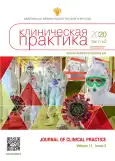Возможности магнитно-резонансной томографии в диагностике поражений легких при COVID-19
- Авторы: Лесняк В.Н.1, Журавлева В.А.1, Аверьянов А.В.2
-
Учреждения:
- Федеральный научно-клинический центр специализированных видов медицинской помощи и медицинских технологий Федерального медико-биологического агентства России
- Научно-исследовательский институт пульмонологии Федерального медико-биологического агентства России
- Выпуск: Том 11, № 2 (2020)
- Страницы: 51-59
- Раздел: Оригинальные исследования
- URL: https://journals.rcsi.science/clinpractice/article/view/34843
- DOI: https://doi.org/10.17816/clinpract34843
- ID: 34843
Цитировать
Полный текст
Аннотация
Обоснование. Методы имидж-диагностики приобрели особое значение во время пандемии COVID-19, а компьютерная томография органов грудной клетки (КТ) стала «золотым стандартом» в выявлении поражения легких, оценке изменений в легочной паренхиме в динамике. Вместе с тем хорошо известно, что метод КТ связан со значимой лучевой нагрузкой, особенно с учетом того обстоятельства, что многим пациентам, болеющим или перенесшим COVID-19, требуются повторные, часто неоднократные контрольные КТ-исследования. С целью потенциального снижения лучевой нагрузки и получения дополнительной диагностической информации мы применили метод магнитно-резонансной томографии (МРТ) при вирусных пневмониях в ФНКЦ ФМБА России, перепрофилированном в центр по лечению пациентов с COVID-19.
Цель — оценить возможности МРТ легких в диагностике пневмоний, вызванных новой коронавирусной инфекцией, описать симптомы, характерные для поражения паренхимы легких с использованием различных импульсных последовательностей, сопоставить полученные результаты с данными КТ.
Методы. Статья основана на опыте применения компьютерной томографии высокого разрешения (КТВР) и МРТ легких у 15 пациентов с пневмониями, вызванными COVID-19.
Результаты. Сопоставление данных КТВР и Т2-взвешенных изображений (Т2-ВИ) выявило в 100% случаев полное соответствие размеров, количества и положения зон снижения воздушности легочной ткани по типу «матового стекла» и зон консолидации. Уровень выявления линейных и ретикулярных изменений при МРТ достигал 73,3%. Свободная жидкость в плевральных полостях в умеренном и минимальном объеме выявлялась на Т2-ВИ у 12 (80%) больных, что не всегда было диагностировано с помощью КТВР. Уверенно визуализировались медиастинальные и внутрилегочные лимфатические узлы. На Т1-взвешенных изображениях (Т1-ВИ) зоны матового стекла либо не визуализировались, либо были представлены меньшими по площади в сравнении с данными КТВР, хуже отображались также ретикулярные изменения. В 73,3% участки консолидации на Т1-ВИ полностью соответствовали или приближались по характеристикам к изменениям на КТВР, при этом стоит отметить, что выполнение T1-ВИ в фазу выдоха (out phase) более четко отображало зоны консолидации по сравнению с Т1-ВИ на вдохе (in phase). У 3 пациентов на фоне участков консолидации были зарегистрированы очаги повышенного сигнала на Т1-ВИ с жироподавлением, что в сопоставлении с данными Т2-ВИ позволило предположить наличие паренхиматозных кровоизлияний.
Заключение. МРТ легких является достаточно чувствительным методом по отношению к выявлению зон «матового стекла» и консолидации, ретикулярных изменений, лимфаденопатии и превосходит КТВР в отображении плеврального выпота. МРТ грудной клетки можно рекомендовать в качестве метода диагностики при подозрении на легочное поражение COVID-19 у детей и беременных для исключения воздействия ионизирующего излучения, а также при мониторинге состояния легочной ткани после перенесенной вирусной пневмонии, если пациент ранее был подвержен высокой лучевой нагрузке.
Ключевые слова
Полный текст
Открыть статью на сайте журналаОб авторах
Виктор Николаевич Лесняк
Федеральный научно-клинический центр специализированных видов медицинской помощи и медицинских технологий Федерального медико-биологического агентства России
Автор, ответственный за переписку.
Email: lesnyak_kb83@mail.ru
ORCID iD: 0000-0002-2739-0649
SPIN-код: 5483-3113
к.м.н.
Россия, МоскваВероника Андреевна Журавлева
Федеральный научно-клинический центр специализированных видов медицинской помощи и медицинских технологий Федерального медико-биологического агентства России
Email: z-vera@bk.ru
ORCID iD: 0000-0003-0558-1142
Россия, Москва
Александр Вячеславович Аверьянов
Научно-исследовательский институт пульмонологии Федерального медико-биологического агентства России
Email: averyanovav@mail.ru
ORCID iD: 0000-0003-1031-6933
SPIN-код: 2229-7100
д.м.н.
Россия, МоскваСписок литературы
- Yan L, Liming X. Coronavirus Disease 2019 (COVID-19): role of chest ct in diagnosis and management. AJR Am J Roentgenol. 2020;214(6):1280–1286. doi: 10.2214/AJR.20.22954.
- Jieyun Z, Zhimei Z, Hongyuan L. CT imaging features of 4121 patients with COVID-19: A meta-analysis. J Med Virol. 2020;92(7):891–902. doi: 10.1002/jmv.25910.
- Abbara S, Sanjeev B. Radiological Society of North America Expert Consensus Statement on reporting chest CT findings related to COVID-19. Endorsed by the Society of Thoracic Radiology, the American College of Radiology, and RSNA. Radiol Cardiothorac Imaging. 2020;2(2):e200152. doi: 10.1148/ryct.2020200152.
- Zheng Y, Zhang Y, Wang Y, et al. Chest CT manifestations of new coronavirus disease 2019 (COVID-19): a pictorial review. Eur Radiol. 2020;1–9. doi: 10.1007/s00330-020-06801-0.
- Carotti M, Salaffi F, Sarzi-Puttini P, et al. Chest CT features of coronavirus disease 2019 (COVID-19) pneumonia: key points for radiologists. Radiol Med. 2020;1–11. doi: 10.1007/s11547-020-01237-4.
- Prokop M, van Everdingen W, van Rees VT, et al. CO-RADS — a categorical CT assessment scheme for patients with suspected COVID-19: definition and evaluation. Radiology. 2020;201473. doi: 10.1148/radiol.2020201473.
- Shionoya Y, Kasai L, Terada J, et al. Cytomegalovirus pneumonia with progressive lung volume loss. Am J Case Rep. 2018;19:1393–1397. doi: 10.12659/AJCR.911708.
- Xing Z, Sun X, Xu L, et al. Thin-section computed tomography detects long-term pulmonary sequelae 3 years after novel influenza a virus-associated pneumonia. Chin Med J (Engl). 2015;128(7):902–908.
- Морозов С.П., Проценко Д.Н., Сметанина С.В., и др. Лучевая диагностика коронавирусной болезни (COVID-19): организация, методология, интерпретация результатов. препринт № ЦДТ-2020-II. Версия 2 от 17.04.2020. Вып. 65. — М.: ГБУЗ «НПКЦ ДиТ ДЗМ», 2020. — 78 с. (Серия: Лучшие практики лучевой и инструментальной диагностики). [Morozov SP, Protsenko DN, Smetanina SV, et al. Luchevaya diagnostika koronavirusnoy bolezni (COVID-19): organizatsiya, metodologiya, interpretatsiya rezul’tatov: preprint № TSDT-2020-II. Version 2 from 17.04.2020. Issue 65. Moscow: Scientific and practical clinical center for diagnostics and telemedicine technologies; 2020. 78 р. (Series: Luchshiye praktiki luchevoy i instrumental’noy diagnostiki). (In Russ).]
- Langenbach MC, Hokamp NG, Persigehl T, Bratke G. MRI Appearance of COVID-19 Infection. Diagn Interv Radiol. 2020. doi: 10.5152/dir.2020.20152.
- Questions and Answers in MRI. Visitors since 2015. Avalable from: https://mriquestions.com/index.html.
- Biederer J, Hirsch W, Beer M, Wild J. MRI of the lung (2/3). Why … when … how? Insights into Imaging. 2012;3:355–371. doi: 10.1007/s13244-011-0146-8.
- Kołodziej M, de Veer MJ, Cholewa M, et al. Lung function imaging methods in Cystic Fibrosis pulmonary disease. Respir Res. 2017;18(1):96. doi: 10.1186/s12931-017-0578-x.
- Yang S, Zhang Y, Shen J, et al. Clinical potential of UTE-MRI for assessing COVID-19: patient- and lesion-based comparative analysis. J Magn Reson Imaging. 2020. doi: 10.1002/jmri.27208.
- Huh J, Kim K, Diffusion-Weighted MR. Enterography to monitor bowel inflammation after medical therapy in crohn’s disease: a prospective longitudinal study. Korean J Radiol. 2017;18(1):162–172. doi: 10.3348/kjr.2017.18.1.162.
Дополнительные файлы











